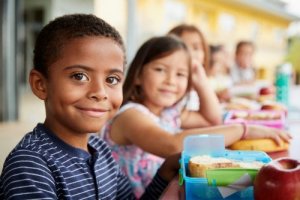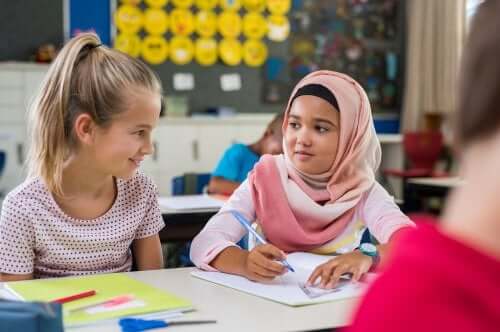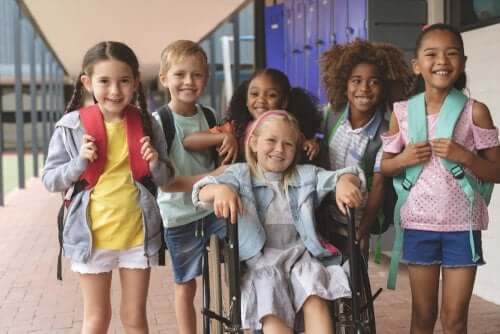The Interactions Among Students at School

Establishing social relationships with peers during childhood and adolescence is key when it comes to optimal and balanced development. Therefore, it’s extremely important for schools to encourage healthy and respectful interactions among students. When they do so, they maximize their students’ social, cognitive and linguistic abilities.
In other words, educational institutions must create spaces that allow for collaboration and cooperation among students. When this is the case, interactions among students become an active resource in the learning process. Children grow up in a diverse climate that promotes the following values:
- Acceptance.
- Respect.
- Inclusion.
- Equality.
“Difference is of the essence of humanity. Difference is an accident of birth and it should therefore never be the source of hatred or conflict. The answer to difference is to respect it. Therein lies a most fundamental principle of peace: respect for diversity.”
– John Hume –
Social interactions among children in academic environments
According to Lewin Johnson, we can define three types of structures regarding the relations that exist between academic goals and the influence of classmates in reaching them:

- Individualist learning. Goals are individual, meaning that the work of others doesn’t impact personal goals. In these cases, each student receives personal recompense for his or her own performance. The results that other classmates obtain have no influence on each individual student’s results.
- Competitive learning. All students strive for the same goals, but one student’s success depends on the failure to reach those goals. In other words, the learning process is exclusive. One student receives the maximum reward while everyone else in the class receives poorer results.
- Cooperative learning. Schools establish collective goals that all of the students can reach. This way, the entire group benefits and receives recompense for the results they obtain.
Keeping this in mind, we can say that the ideal way to encourage good interactions between students is to apply the cooperative learning structure. At the same time, this means we should step away from the individualist and competitive academic structures of traditional academic environments. Therefore, educators need to organize their classes so that the function of teaching falls on teachers and students alike.
“Cooperation is the thorough conviction that nobody can get there unless everybody gets there.”
– Virginia Burden –
Forming heterogeneous groups for interaction
Collaborative interactions among students lead to improvements in the following aspects:
- Group cohesion.
- Harmony – the ability to get along with one another.
- Teamwork.
However, for this to take place, the groups created for cooperative work should be:
- Small in size: No more than three to five students per group.
- Heterogeneous: Groups should include students with diverse abilities, motivations, needs, etc.

For that matter, it’s important to point out that forming these diverse teams requires mixing boys and girls in different groups. At the same time, educators should evaluate the possible compatibilities and incompatibilities that exist among classmates.
Once teachers take these considerations into account, they can then distribute their students into three subgroups:
- Those who have a greater ability to help others.
- Those who need more help in order to complete school work.
- The rest of the class.
When teachers establish groups, they should include at least one student from each of these subgroups in each work team.
For example, let’s say that a teacher decides to create a team of four students. Ideally, this team would consist of one student that can help others and one student who needs more help. The remaining teammates would have more average academic abilities.
“Inclusion is not simply about physical proximity. It is about intentionally planning for the success of all students.”
– Daniel Comin –
Establishing social relationships with peers during childhood and adolescence is key when it comes to optimal and balanced development. Therefore, it’s extremely important for schools to encourage healthy and respectful interactions among students. When they do so, they maximize their students’ social, cognitive and linguistic abilities.
In other words, educational institutions must create spaces that allow for collaboration and cooperation among students. When this is the case, interactions among students become an active resource in the learning process. Children grow up in a diverse climate that promotes the following values:
- Acceptance.
- Respect.
- Inclusion.
- Equality.
“Difference is of the essence of humanity. Difference is an accident of birth and it should therefore never be the source of hatred or conflict. The answer to difference is to respect it. Therein lies a most fundamental principle of peace: respect for diversity.”
– John Hume –
Social interactions among children in academic environments
According to Lewin Johnson, we can define three types of structures regarding the relations that exist between academic goals and the influence of classmates in reaching them:

- Individualist learning. Goals are individual, meaning that the work of others doesn’t impact personal goals. In these cases, each student receives personal recompense for his or her own performance. The results that other classmates obtain have no influence on each individual student’s results.
- Competitive learning. All students strive for the same goals, but one student’s success depends on the failure to reach those goals. In other words, the learning process is exclusive. One student receives the maximum reward while everyone else in the class receives poorer results.
- Cooperative learning. Schools establish collective goals that all of the students can reach. This way, the entire group benefits and receives recompense for the results they obtain.
Keeping this in mind, we can say that the ideal way to encourage good interactions between students is to apply the cooperative learning structure. At the same time, this means we should step away from the individualist and competitive academic structures of traditional academic environments. Therefore, educators need to organize their classes so that the function of teaching falls on teachers and students alike.
“Cooperation is the thorough conviction that nobody can get there unless everybody gets there.”
– Virginia Burden –
Forming heterogeneous groups for interaction
Collaborative interactions among students lead to improvements in the following aspects:
- Group cohesion.
- Harmony – the ability to get along with one another.
- Teamwork.
However, for this to take place, the groups created for cooperative work should be:
- Small in size: No more than three to five students per group.
- Heterogeneous: Groups should include students with diverse abilities, motivations, needs, etc.

For that matter, it’s important to point out that forming these diverse teams requires mixing boys and girls in different groups. At the same time, educators should evaluate the possible compatibilities and incompatibilities that exist among classmates.
Once teachers take these considerations into account, they can then distribute their students into three subgroups:
- Those who have a greater ability to help others.
- Those who need more help in order to complete school work.
- The rest of the class.
When teachers establish groups, they should include at least one student from each of these subgroups in each work team.
For example, let’s say that a teacher decides to create a team of four students. Ideally, this team would consist of one student that can help others and one student who needs more help. The remaining teammates would have more average academic abilities.
“Inclusion is not simply about physical proximity. It is about intentionally planning for the success of all students.”
– Daniel Comin –
All cited sources were thoroughly reviewed by our team to ensure their quality, reliability, currency, and validity. The bibliography of this article was considered reliable and of academic or scientific accuracy.
- De la Corte, C. M. (2017). Relación entre iguales, personalidad y problemas de ajuste en escolares de primaria de Huelva (Tesis doctoral). Huelva: Universidad de Huelva.
- García-Fernández, J. A. (1993). Interacción entre iguales en entornos de integración escolar: un ensayo de desarrollo profesional con profesores de educación infantil y de EGB (Tesis doctoral). Madrid: Universidad Complutense de Madrid.
This text is provided for informational purposes only and does not replace consultation with a professional. If in doubt, consult your specialist.








